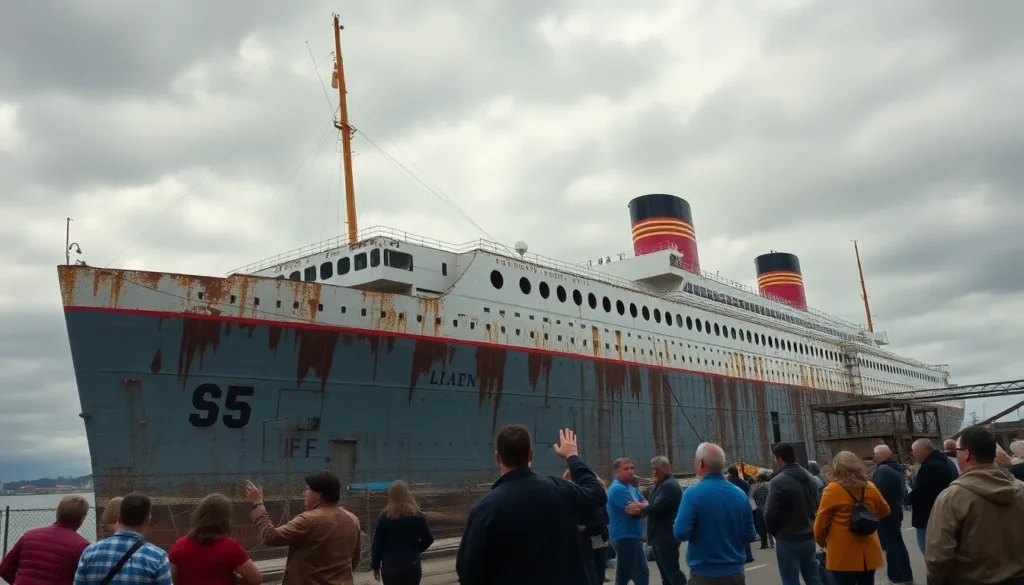Table of Contents
ToggleThe SS United States, once a majestic ocean liner, is now facing an uncertain fate that’s as turbulent as the seas it once sailed. This iconic vessel, a symbol of American ingenuity and luxury, is on the brink of being scrapped, leaving many to wonder if this is the end of an era or merely a plot twist in its storied history.
Overview of the SS United States
The SS United States, launched in 1952, served as a marvel of maritime engineering and design. Designed by naval architect William Francis Gibbs, it showcased innovative features that set new standards in speed and luxury. This ocean liner could travel at an impressive speed of 38 knots, making it one of the fastest passenger ships ever built.
Operating as a transatlantic liner, it connected U.S. cities with Europe, offering a unique travel experience. The ship accommodated over 2,000 passengers in a blend of elegance and comfort, featuring luxurious staterooms, a grand dining room, and an onboard pool. Frequently favored by celebrities and dignitaries, the SS United States became a floating symbol of prestige.
Despite its grandeur, the ship’s operational days ended in 1969, largely due to the rise of air travel. After its retirement, it faced neglect and deterioration, leading to discussions about its future. Preservation efforts surfaced periodically, with passionate advocates aiming to save the vessel and repurpose it as a museum or hotel.
The looming possibility of scrapping raises significant concerns about losing a key piece of American history. Many view this vessel as a testament to the United States’ post-war optimism and innovation. The SS United States remains a poignant reminder of maritime legacy, illustrating the balance between heritage conservation and modern realities.
Historical Significance of the SS United States
The SS United States embodies an essential part of maritime history. Renowned for its technological innovations and cultural impact, this vessel represents a remarkable era in American engineering and transatlantic travel.
Design and Construction
Naval architect William Francis Gibbs designed the SS United States with a focus on speed and safety. This ocean liner, launched in 1952, featured an aluminum superstructure, lightweight materials, and cutting-edge engineering that minimized drag. The ship’s streamlined design contributed to its record-setting speed of 38 knots, achieving a transatlantic crossing in just over three days. The construction involved extensive planning and craftsmanship, leading to a vessel that combined aesthetic elegance with superior performance. Innovations in its design aimed to provide passengers with unparalleled luxury while ensuring operational efficiency.
Notable Achievements
The SS United States holds several prestigious records in maritime history. It completed its maiden voyage in 1952, capturing the Blue Riband for the fastest Atlantic crossing, a title it maintained for over three decades. The ship became a preferred choice for celebrities, presidents, and dignitaries, establishing a reputation synonymous with excellence. During its operational years, it served as a vital link between America and Europe, symbolizing U.S. post-war revival. The vessel’s design innovations and achievements not only demonstrated engineering prowess but also reflected the optimism and aspirations of a nation embracing modernity.
Current Condition of the Ship
The SS United States remains in a state of disrepair, reflecting years of neglect and exposure to the elements. Preservation efforts face challenges due to the ship’s deteriorating condition.
Maintenance and Repairs
Maintenance efforts on the SS United States have been sporadic. A lack of funding often hampers necessary repairs. Rust and corrosion significantly affect the vessel’s integrity, with structural concerns increasingly arising as time passes. Efforts by preservationists have aimed at stabilizing the ship’s hull and preventing further decay. Some initiatives focused on securing grants and support from maritime organizations. Despite these endeavors, the vessel’s future remains uncertain without consistent maintenance.
Environmental Concerns
Environmental risks tied to the SS United States have drawn attention from various stakeholders. The potential for leaking fuel and hazardous materials poses a threat to surrounding ecosystems. As the ship deteriorates, pollutants may leach into local waters, raising alarms among environmental groups. Communities near the dock have expressed concerns, advocating for prompt action. Scrapping the vessel raises questions about responsible disposal methods, particularly regarding toxic materials. Addressing these concerns is essential for protecting coastal environments while considering the ship’s fate.
Reasons for Scrapping
Various factors contribute to the decision to scrap the SS United States, ranging from financial viability to preservation challenges. Each aspect plays a critical role in determining the vessel’s fate.
Financial Viability
Operating costs for the SS United States remain prohibitively high. Maintenance needs, coupled with the expenses related to restoration, require substantial financial investment. Current funding sources have diminished, limiting opportunities for extensive repairs. Income generated by potential tours or events cannot offset the mounting expenses. Without a solid financial plan, scrapping becomes a more attractive option for stakeholders.
Preservation Challenges
Numerous preservation challenges hinder efforts to restore the SS United States. Weather exposure has caused significant deterioration, leading to extensive rust and corrosion. Preservationists face ongoing difficulties in securing the necessary resources for maintenance. Regular upkeep has proven inconsistent, increasing threats to the vessel’s integrity. Environmental regulations complicate the scenario, as hazardous materials onboard raise concerns about safe removal. Continued neglect may push advocates to consider scrapping as the only viable solution.
Future Prospects
Concerns about the SS United States’ future prompt discussions on preservation and alternative solutions. Options remain limited, yet innovative ideas continue to emerge.
Potential Alternatives
Repurposing the SS United States as a museum generates interest among maritime enthusiasts. This concept could showcase its rich history and technological achievements. Another alternative involves transforming the vessel into a hotel or event space, appealing to tourists and businesses. Utilizing the ship as a floating restaurant leverages its unique design and location. Stakeholders could explore partnerships with preservation organizations to secure funding, fostering community engagement. Innovative programming might attract visitors, enhancing its relevance in today’s culture.
Preservation Efforts
Preservationists work tirelessly to stabilize the SS United States despite challenges. Funding obstacles have hindered maintenance, often resulting in deteriorating conditions. Local communities mobilize to support initiatives aimed at saving the ship, highlighting its historical significance. Collaboration with maritime experts may offer valuable insights into restoration techniques. Environmental regulations necessitate careful planning to manage hazardous materials on board. Engaging the public through awareness campaigns fosters a sense of ownership, encouraging participation in preservation activities. Continued advocacy remains crucial for the future of the vessel.
The fate of the SS United States hangs in the balance as advocates strive to preserve its legacy. This iconic vessel represents not just maritime engineering but also a significant chapter in American history. The challenges of restoration and funding are daunting but not insurmountable.
With community support and innovative ideas, there’s still hope for the ship to be transformed into a vibrant museum or event space. The urgency of responsible action is clear as stakeholders consider the implications of scrapping such a historic treasure. The collective efforts of preservationists and local communities may yet breathe new life into the SS United States, ensuring its story continues for future generations to appreciate.




